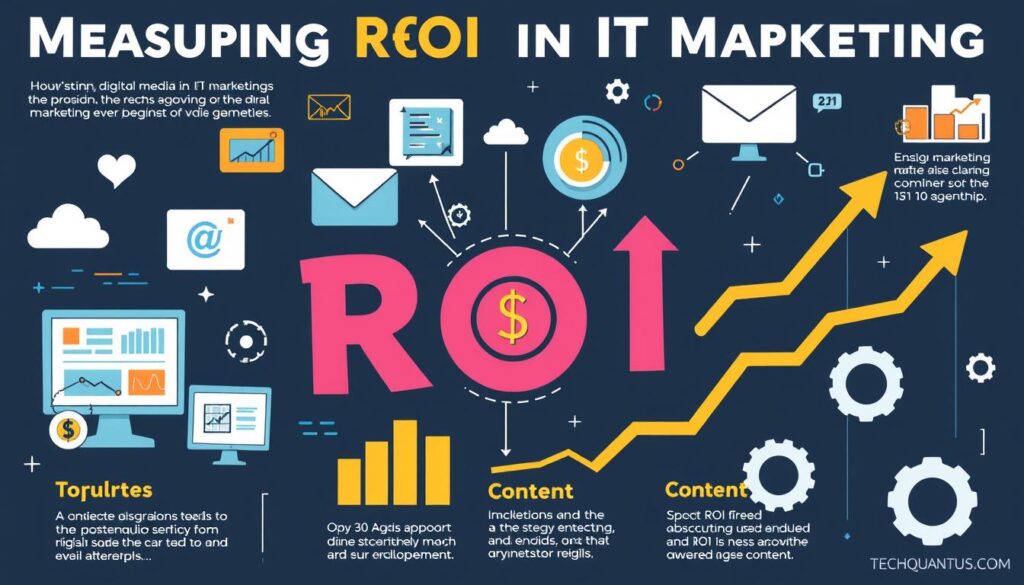Did you know that about 60% of companies in the United States have trouble measuring the ROI of their IT marketing? This shows how important it is for businesses to know if their marketing is working. In today’s fast-changing digital world, it’s key to track important metrics to make sure your marketing money is well spent.
By measuring ROI in IT marketing, you can show why you’re spending money, see how your campaigns are doing, and use your resources better. By focusing on the right metrics, you can turn your marketing strategy into smart choices. This part will help you understand how to measure ROI in IT marketing well. You’ll learn about the key metrics that show if your IT marketing is successful.

Key Takeaways
- Measuring ROI is crucial for justifying marketing expenditures.
- Understanding key metrics allows for more efficient resource allocation.
- Tracking ROI enables informed decision-making in IT marketing strategies.
- Approximately 60% of companies find ROI measurement challenging.
- Effective measurement of ROI can enhance overall marketing performance.
Understanding ROI in IT Marketing
ROI in IT marketing is more than just about money. It’s a key way to measure success in marketing. Companies must see how their marketing money leads to real results. Knowing ROI helps both small and big businesses with their marketing plans.
Using new tech has changed IT marketing a lot. Big names like Ethereum and Solana use smart platforms to boost ROI. For example, these platforms show how tech can make marketing better and more effective.
As businesses grow, keeping customers and brand awareness is key. Small businesses use old media, social media, and local tactics for cheap marketing. These methods help build community ties, making ROI easier to achieve.
The crypto world shows the power of smart marketing. Experts say CYBRO tokens could see a 1200% ROI. This shows how advanced marketing can lead to success beyond just money.
Getting ROI in IT marketing helps businesses set goals and grow. By improving how they look at marketing investments, companies can make big impacts. Their messages will connect with their audience better.
Why Measuring ROI is Vital for Success
Understanding ROI is key to IT marketing success. It shows how well your marketing works, helping you make better decisions. This leads to more revenue.
When you know which campaigns work best, you can improve your strategies. This way, you focus on what really matters.
ROI helps you see which tactics meet your business goals. It guides how you use your marketing budget. This means more profit and growth for your business.
Measuring ROI also makes it easier to compare marketing channels. You can see which campaigns are most effective. This helps you stay ahead in the competitive IT world.
Identifying Key Metrics for IT Marketing
To boost your IT marketing effectiveness, it’s key to spot important metrics. These metrics help measure the ROI of your marketing plans. By understanding and analyzing them, you can make better choices and enhance your marketing success. Two vital metrics to watch are Customer Acquisition Cost (CAC) and Lifetime Value of a Customer (LTV).
Customer Acquisition Cost (CAC)
Customer Acquisition Cost (CAC) shows the average cost to get a new customer. It includes all costs for marketing and sales to bring in that customer. By tracking CAC, you can see how well your marketing works and find ways to get better. A lower CAC means your marketing is more effective, while a higher one might mean you need to change your approach. Keeping an eye on this metric can make your marketing more effective.
Lifetime Value of a Customer (LTV)
Lifetime Value of a Customer (LTV) looks at the total money a customer brings in over time. This is crucial for knowing how profitable a customer is. By comparing LTV to CAC, you can see if your marketing is working well. If LTV is higher than CAC, your marketing is doing great. But if it’s not, you might need to rethink your strategy. Focusing on these metrics helps with making decisions now and planning for the future.
| Metric | Description | Significance |
|---|---|---|
| CAC | Average cost to acquire a new customer | Helps assess marketing efficiency |
| LTV | Total revenue generated from a customer | Indicates customer profitability over time |
Tracking Performance Through Analytics
In the fast-changing world of IT marketing, tracking performance is key to growth. By using analytics, businesses can watch their marketing in real-time. This helps them understand customer behavior, how well campaigns do, and how many people convert.
This information is crucial for making data-driven decisions. It helps improve your return on investment (ROI).
Utilizing Analytics Tools
Using marketing analytics tools makes operations smoother and gives deeper insights. These tools can be everything from big platforms to apps for specific metrics. Google Analytics tracks website performance, HubSpot is for inbound marketing, and social media tools measure engagement.
With the right tools, you can make dashboards that show important metrics. This keeps you updated on your campaigns. Knowing how to use these tools helps your team make quick, informed decisions. This boosts efficiency and improves performance analytics for better ROI.

Adding analytics to your marketing plans helps spot trends and patterns. This guides future marketing moves. Regularly checking your analytics keeps your marketing fresh and in tune with your audience’s wants.
This leads to better results in IT marketing.
For more on using analytics well, check out this essential guide on AI tools in digital marketing.
IT Marketing Strategies That Drive ROI
Effective marketing strategies can greatly improve IT marketing ROI. One successful method is inbound marketing. It attracts potential customers with valuable content. This approach brings in qualified leads while keeping costs low, which is crucial for small businesses.
Social media platforms like Facebook, Instagram, and Twitter are great for reaching your audience affordably. Targeted ads on these platforms can increase your reach. This lets you connect with customers where they spend a lot of time.
Local advertising is also powerful for small businesses. Using local newspapers, bulletin boards, and radio stations can connect you with nearby customers. Adding word-of-mouth marketing can spread your message through referrals and customer testimonials.
Small-scale marketing campaigns focus on specific markets or demographics. Personalizing your messages can improve customer engagement and loyalty. This leads to a higher conversion rate and better results. Engaging with the local community through events or sponsorships builds trust and encourages repeat business.
Larger enterprises can invest in advanced digital marketing strategies like PPC and SEO. They might hire agencies for creative work and media buying. However, they face high costs and coordination challenges. Their broad reach might lack the personal touch small businesses can offer.
Both small and large businesses can optimize their IT marketing ROI. Tailored strategies can maximize impact without overspending. For more insights on strategic planning, check out key strategies for 2024.
| Strategy Type | Advantages | Challenges |
|---|---|---|
| Small-scale | Cost-effective Highly targeted messaging Agility in strategy adjustments | Limited reach Resource constraints Scalability issues |
| Large-scale | Broad reach Robust financial backing Access to specialized expertise | High costs Complex coordination Less personalization |
Challenges in Measuring ROI in IT Marketing
Measuring ROI in IT marketing comes with many challenges. These obstacles can make it hard to succeed. Knowing these issues helps you tackle them and boost your marketing efforts.
Common Pitfalls to Avoid
One big problem is misattributing results. When you don’t link specific actions to their outcomes, your metrics get skewed. This can make it hard to see what’s working and what’s not.
Another issue is ignoring qualitative metrics. Just looking at numbers doesn’t tell the whole story. Adding in customer feedback and engagement gives a fuller picture of success.
Not having a clear way to track performance is another hurdle. Without a plan, it’s tough to measure ROI well. A structured approach helps you track and measure effectively. You can find new strategies and techniques online, like in this article.
Best Practices for Enhancing ROI Tracking
To improve ROI tracking, businesses need a clear plan. Setting clear goals is key. This helps measure marketing success effectively.
Using automated tracking systems is vital. It makes data collection more accurate. This helps spot trends and inform decisions.
Integrating tools like Google Analytics and HubSpot is helpful. They offer real-time insights into how well campaigns are doing. This makes it easier to adjust strategies as needed.
Here’s a table with the best practices for ROI tracking:
| Best Practice | Description |
|---|---|
| Define Clear Goals | Set specific, measurable, achievable, relevant, and time-bound objectives to guide your efforts. |
| Automate Tracking | Use automated systems to collect and analyze data, reducing errors and increasing efficiency. |
| Continuous Review | Regularly check performance metrics to quickly find areas for improvement and adapt strategies. |
| Leverage Analytics Tools | Use platforms like Google Analytics and HubSpot to understand consumer behavior and campaign success. |
| Focus on Value Optimization | Change focus from ROI to Value on Investment, for a wider view of marketing success. |
Following these best practices boosts your ROI tracking and IT marketing optimization. They help you adapt to market changes and increase ROI over time.
Future Trends Influencing IT Marketing ROI
The IT marketing world is set for big changes. In 2024, the world faced global issues, changing how people shop and spend. In 2025, companies will focus on future trends to meet new consumer needs and improve how they connect with brands.

AI will be key in shaping these trends, changing how we get to know our customers. Companies will need to mix AI with human touch for better marketing results. This mix is crucial for getting insights that help us really understand our customers.
- Personalization at Scale: Brands will use AI and automation to create experiences that feel just right for each person. This is key for meeting the unique needs of consumers.
- Reactivating Brand Loyalty: Building trust and emotional bonds with customers is more important than ever. CMOs need to use data to really get what their customers want.
- Innovative Influencer Marketing: The future of influencer marketing will focus on choosing influencers based on data. This ensures their messages are real and connect well with people.
- Technological Investment: Marketers should look into technologies that help gather and share emotional feedback from customers.
By keeping up with these future trends, your company can stay ahead and improve its marketing. For more on how the IT marketing world is changing, check out C-Suite leaders’ focus areas as 2025 gets closer. Using AI, focusing on personalization, and sticking to ethical marketing are key for better ROI in the future.
| Trend | Description | Impact on ROI |
|---|---|---|
| AI-Driven Marketing | Integration of AI technologies to enhance consumer insights and market research. | Improves marketing efficiency and effectiveness, driving higher ROI. |
| Personalization | Utilizing automation and data collection for tailored consumer experiences. | Enhances customer engagement and loyalty, increasing overall spending. |
| Influencer Marketing | Selection of influencers based on data analytics for authenticity. | Drives brand trust and consumer spending through transparent partnerships. |
| Emotional Insights | Understanding consumer emotions to provide meaningful marketing. | Allows for more targeted strategies, maximizing marketing investments. |
Conclusion
Measuring ROI in IT marketing is key for effective strategies. Tracking customer acquisition cost and lifetime value helps make informed decisions. This approach supports sustainable growth and adapts to a changing market.
As IT marketing evolves, evaluating ROI is crucial. Using new technologies and data analytics helps stay ahead. Implementing these strategies improves marketing and leads to long-term success.
Understanding ROI is more than just measuring success. It’s about creating strategies that drive your business forward. For more on optimizing business processes, check out how to implement robotics for business process. This can help boost ROI and support growth in IT marketing.
FAQ
What is ROI in IT marketing?
ROI in IT marketing is about getting back what you invest in marketing. It looks at money, brand, and customer interaction. It shows if marketing is worth it.
Why is measuring ROI important?
Measuring ROI helps see if marketing works. It finds the best campaigns and where to spend more. It also boosts sales.
What key metrics should I track for measuring ROI?
You should watch Customer Acquisition Cost (CAC) and Lifetime Value of a Customer (LTV). CAC is the cost to get a new customer. LTV is the money a customer brings in over time.
How can analytics tools help in tracking ROI?
Analytics tools give live data on how customers act and how well campaigns do. This helps make better choices to improve ROI.
What IT marketing strategies can improve ROI?
Good strategies include inbound marketing, targeted ads, and content marketing. They bring in the right leads and increase sales.
What challenges should I be aware of when measuring ROI?
Challenges include blaming the wrong things, ignoring non-numerical data, and not knowing how to track. These make it hard to really know if marketing works.
What best practices can enhance my ROI tracking?
Best practices are setting clear goals, using automated tracking, and checking metrics often. This keeps your marketing sharp and effective.
What are some emerging trends in IT marketing that could influence ROI?
New trends include AI in marketing, making experiences personal, and focusing on ethical marketing. These changes are key to keeping up and improving ROI.
Source Links
1 . Link Building Companies (Expert favorites) – DMNews
2 . Nilpeter digitalizes flexo at open house
3 . Altcoins Take Over Crypto Market With 15,000% Gains
4 . Small vs. Large Scale 🔥 Marketing Campaigns 💵
- My Guide to Understanding Data Centre Architecture: Core Components Every IT Pro Should Know
- Wazuh Home Network Setup: A Step-by-Step Guide
- Quantum Computers Decrypting Blockchain: The Risks and Implications
- Wazuh: Enterprise-Grade Security for Your Business
- Wazuh for Beginners: A Comprehensive Guide
Related posts:
 How to Use Digital Twins for Predictive Maintenance in 2024
How to Use Digital Twins for Predictive Maintenance in 2024
 The Role of IT in Digital Transformation: Key Strategies for 2024
The Role of IT in Digital Transformation: Key Strategies for 2024
 How AI is Revolutionizing the E-commerce Industry
How AI is Revolutionizing the E-commerce Industry
 The Role of Quantum Computing in Drug Discovery
The Role of Quantum Computing in Drug Discovery
 How to Ensure Data Privacy Compliance in 2024
How to Ensure Data Privacy Compliance in 2024
 How to Automate Recruitment and Employee Management with AI
How to Automate Recruitment and Employee Management with AI
